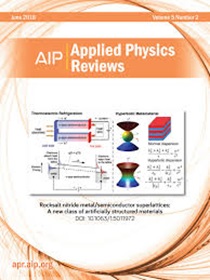Defect-induced magnetic symmetry breaking in oxide materials
IF 11.6
1区 物理与天体物理
Q1 PHYSICS, APPLIED
引用次数: 0
Abstract
Magnetic properties of crystalline solids are fundamental to a wide range of applications, capturing the attention of a vast scientific community. Thus, engineering magnetic order in materials such as ferromagnetism and antiferromagnetism holds great scientific and technological interest. Defects such as vacancies, interstitials, and dopants induce local perturbations within the crystal lattice. These perturbations locally disturb the entire symmetry of crystals, resulting in symmetry breaking. Oxides, in particular, exhibit intriguing properties when subjected to defects, which can lead to significant modifications in their structural, electronic, and magnetic properties. Such defects in non-magnetic oxides can induce magnetic symmetry breaking, leading to the formation of emergent magnetic domains and orderings. In this review, we focus on the recent progress in magnetic breaking symmetries in materials via defect engineering and present our perspectives on how these may lead to new understanding and applications.氧化材料中缺陷引起的磁对称性破缺
晶体固体的磁性是广泛应用的基础,引起了广大科学界的关注。因此,铁磁性和反铁磁性等材料的工程磁序具有重大的科学和技术意义。空位、间隙和掺杂等缺陷会引起晶格内部的局部扰动。这些扰动局部扰乱了晶体的整个对称性,导致对称性破坏。特别是氧化物,当受到缺陷时,会表现出有趣的特性,这可能导致它们的结构、电子和磁性能发生重大变化。这种缺陷在非磁性氧化物中会引起磁对称性破缺,导致紧急磁畴和有序的形成。在这篇综述中,我们重点介绍了通过缺陷工程研究材料中磁破对称性的最新进展,并就这些进展如何导致新的理解和应用提出了我们的观点。
本文章由计算机程序翻译,如有差异,请以英文原文为准。
求助全文
约1分钟内获得全文
求助全文
来源期刊

Applied physics reviews
PHYSICS, APPLIED-
CiteScore
22.50
自引率
2.00%
发文量
113
审稿时长
2 months
期刊介绍:
Applied Physics Reviews (APR) is a journal featuring articles on critical topics in experimental or theoretical research in applied physics and applications of physics to other scientific and engineering branches. The publication includes two main types of articles:
Original Research: These articles report on high-quality, novel research studies that are of significant interest to the applied physics community.
Reviews: Review articles in APR can either be authoritative and comprehensive assessments of established areas of applied physics or short, timely reviews of recent advances in established fields or emerging areas of applied physics.
 求助内容:
求助内容: 应助结果提醒方式:
应助结果提醒方式:


